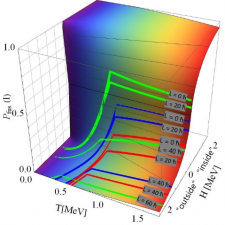Scientists from NCBJ and UW have published a paper explaining what determines the success of the synthesis of the nuclei of the heaviest elements in fusion reactions. The performed calculations show that the dramatic decrease in the probability of synthesis with the increase in the atomic number of the nucleus formed can be explained assuming that the fusion takes place in the process of diffusion.
Super heavy elements with atomic numbers greater than 103 do not occur in nature. They can be produced in the laboratory by fusing two lighter nuclei. One of the production methods is the so-called cold synthesis, in which the nuclei of a relatively light element accelerated in the cyclotron strike a target made of lead or bismuth. As a result of the collision of the projectile nuclei and the target, a highly interacting system is created, which with a certain probability, known as the fusion probability, can be combined. The newly formed nucleus with an atomic number equal to the sum of the atomic numbers of the nuclei of the projectile and the target is called a complex nucleus. Such a system is „hot” right after being produced – it has a surplus of energy in relation to its basic state and is not stable. In a very short time, such a system gets rid of excess energy through three competing processes: fission, neutron emission and gamma radiation, with fission being the predominant process. The term „cold fusion” means that the nuclei of super heavy elements formed in such a reaction are not too strongly excited (they have a low temperature), which increases their chance of survival. During the cooling process, they emit only one or two neutrons and gamma radiation. So far, the nuclei of super heavy elements with atomic numbers from 104 to 113 have been produced in the „cold synthesis” reactions.
The „cold synthesis” process can be divided into three stages. In the first stage, the projectile nucleus must adequately approach the target nucleus, overcoming the charge repulsion barrier (both nuclei are positively charged). The next stage is the fusion of the two nuclei and the formation of an excited complex nucleus. The last step is to get rid of excess energy and move to the end state. The course of the intermediate stage, i. e. the fusion process, is the most difficult to analyze and describe in the synthesis of the nuclei of super heavy elements. Despite many years of research, there is no consensus among scientists as to what its mechanism is.
The experimental data for the „cold fusion” reaction show that the cross section for the production of super heavy elements nuclei (a measure of the probability of production) drops by as much as six orders of magnitude with the change of the nucleus of a titanium projectile with atomic number 22 to zinc with atomic number 30. The authors of the paper, which Was published today in the Physical Review C – Letters (https://link.aps.org/doi/10.1103/PhysRevC.105.L051601) argue that the intermediate stage of the reaction is responsible for this dramatic decrease in the cross-sectional area. “ We have shown that the experimentally determined fusion probabilities for the three „cold fusion” reactions can be well described, assuming that the process of fusing the projectile and the target nuclei takes place by diffusion through the barrier separating the nuclei contact point from the complex nucleus configuration” – informs Prof. Krystyna Siwek-Wilczyńska from the Faculty of Physics at the University of Warsaw, co-author of the work. „In the calculations, we used a model in which the probability of fusion is determined by solving the Smoluchowski diffusion equation with an appropriately assumed shape of the barrier. This approach, as it turned out, gives a physical and very intuitive picture of the process."
The fusion probability for a given reaction is not a constant value, but varies with the energy available. „From the reaction threshold energy to an energy slightly above the height of the Coulomb barrier, the fusion probability increases rapidly,” explains co-author of the work, PhD. Tomasz Cap from the Department of Theoretical Physics of the National Center for Nuclear Research (NCBJ). „For the higher energies, the probability is approximately constant. „It turned out to be of key importance for understanding the behavior of the fusion probability to include in the model used the angular momentum that the system obtains during the reaction. „We found that the success of a fusion depends on two opposing effects,” says the third co-author, PhD. Michał Kowal from the NCBJ Theoretical Physics Department. „On the one hand, as the available energy increases, the diffusion process begins at smaller and smaller distances between the projectile and the target’s nuclei, which increases the chance of success. On the other hand, the contribution from higher partial waves then increases, which raises the fusion barrier and leads to a decrease in the probability of fusion. The interplay of these two effects determines the optimal conditions for the merger to take place."
The authors of the study showed that the proposed reaction model can reproduce the observed values of cross-sections for the production of the nuclei of the heaviest elements. The explanation of experimentally determined fusion probabilities is an important step in understanding the forbidden phenomenon occurring in the synthesis reactions of super heavy elements nuclei. „Understanding the phenomenon of forbidding fusion is crucial in selecting the optimal projectile-target combinations for the synthesis of new elements with atomic numbers above 118” – summarizes PhD. Michał Kowal.
Figure from the work: Probability of fusion Pfus (l) as a function of temperature T and barrier height H (l) for different angular momentum values l (0, 20, 40 and 60 ℏ) . Calculations for three missiles: 48Ca (green), 50Ti (blue), 54Cr (red) interacting with 208Pb nuclei. The color of the surface shows the change in temperature of the system.







